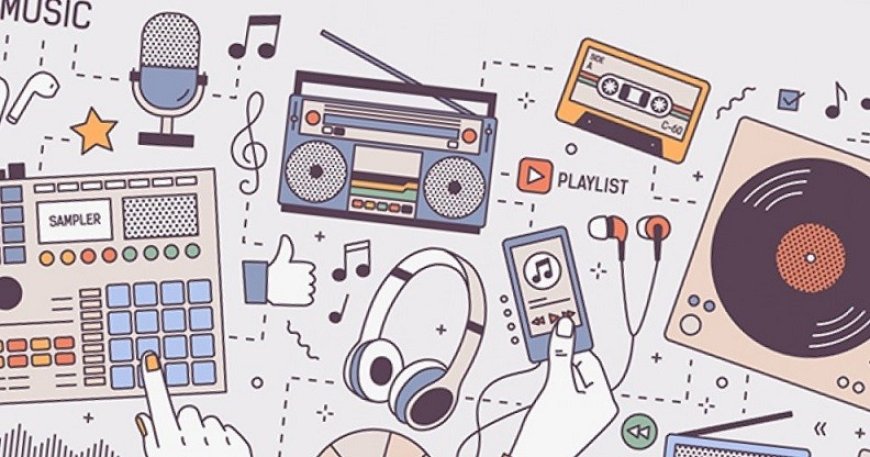'Physical Media' and blinking screens
In the journey from stones and rocks to paper, communication used to be in one place with static and stagnant embodied words,

In the history of communication through various human symbols or words, sometimes stones were chosen to express it, sometimes rocks ... Then, through the bark of trees and the skins of various animals, etc., this chain reached to modern and advanced means like 'paper'.
It didn't stop there either, but with the scientific development after the Industrial Revolution it started to be heard on the 'radio' and then on the 'moving screen', then from here on the 'moving pictures' of the 'TV'. In that case, a revolution was started from house to house. Then it did not die here, but today it has become an integral part of our lives and yours in the form of 'computer' and then mobile.
Under the evolutionary stages of expression, although it is not known how many centuries it took to reach this point in the 21st century, the 'expression' or text that appeared on the screen and the lightning of the electron became the embodiment or 'physical form' of the message or text. 'Snatched ...!
In the journey from stones and rocks to paper, communication used to be in one place with static and stagnant embodied words, but in the modern electronic media this element has been completely eliminated, now any writing on computer, mobile or TV. When it burns, it shines on the screen or glass and then disappears. Then another writing begins to emerge on the same glass, that is, on the same source or 'means' we can see and read hundreds to thousands of things from morning to evening. It includes all the treasures of letters and private messaging, from many general messages to news, analysis, commentary, theology, literature and modern and ancient sciences and arts.
It is also important to mention here the important communicative theory of the eminent Canadian philosopher Marshall McLuhan that 'The medium is the message! Yes, but it is very clear that Marshall McLuhan pointed this out 50 years ago in 1964, on which we are now forced to think that there is no message or word, but the one who spreads and conveys it. The source is so important that it can be called the original 'message'.
Considering the message conveyed by today's state-of-the-art '3D' technology, how easy it is to understand the meaning of Marshall McLohan's (1911“1980) quote decades ago that 'source That's the message ...! '
What a wonderful way to screw people over, so that today, with the help of modern means of communication, it is possible to talk directly to anyone sitting thousands of miles away, see them laughing, talking and crying, but not you. You can pat him on the back, it is not possible to shake hands with him and there is no way to give him a sense of belonging by embracing him.
If you are thinking that even in a traditional paper letter you can't do all this, but you can definitely 'feel' the touch of your loved one's hand and its 'fragrance' through this paper letter. There is a feeling of being touched by that beloved in the heart, then in this 'embodied letter' tears dripping from the emotions are also absorbed and give a feeling of closeness, even if the ink does not spread from these tears. Even then, most of the time, the paper slots tell that the eyes are sealed here. And these tears convey a message that is probably not possible with words ...!
In handwritten text, even our writing style, i.e. 'artical letter', makes a 'communication' to our addressee, sometimes the hand staggers, and the word expressing our grieving emotion is also written in a sad style, Somewhere, even the words of joy begin to flow and its twists and turns begin to address the happiness of the writer.
The effect of still, embodied and still material on one's reader is also a matter of research. See, no matter if something is just heard, heard and seen or just read and then read on a piece of paper or some other 'physical resource' through an electronic glass, what difference does it make in storing it in our memory?
By 'physical media' we mean not only 'printed media' ie newspapers, books and magazines and journals etc. but also all those media including any message without any 'electronic'. We have in front of us in its embodied and fixed form, such as wall advertisements, wall chalking, articalers, banners, printed billboards, pamphlets and many other such materials. In addition, any writing on stamps, coins, paper notes, our clothes, bags or anything else can be counted as 'physical medium' or 'physical medium'.
Bright screens do not need electricity, they can be dark for any other technical reason, while the 'physical media' are far beyond any such need, for which only the presence of light is the only condition.
The print media has to compete with the 'speed' of time, because electronic media can deliver anything in just a few moments, while the print media, despite being easy to print and publish, is still far from it. It takes time. On the other hand, printed material can be read anytime, and can be taken anywhere, while this facility for 'electronic content' is conditional, if any, on mobile, electricity and internet! And there is content.
